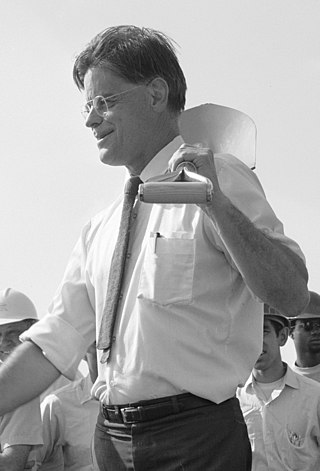
Glenn Theodore Seaborg was an American chemist whose involvement in the synthesis, discovery and investigation of ten transuranium elements earned him a share of the 1951 Nobel Prize in Chemistry. His work in this area also led to his development of the actinide concept and the arrangement of the actinide series in the periodic table of the elements.
Seaborgium is a synthetic chemical element; it has symbol Sg and atomic number 106. It is named after the American nuclear chemist Glenn T. Seaborg. As a synthetic element, it can be created in a laboratory but is not found in nature. It is also radioactive; the most stable known isotopes have half lives on the order of several minutes.

Ernest Orlando Lawrence was an American nuclear physicist and laureate of the Nobel Prize in Physics in 1939 for his invention of the cyclotron. He is known for his work on uranium-isotope separation for the Manhattan Project, as well as for founding the Lawrence Berkeley National Laboratory and the Lawrence Livermore National Laboratory.
The names for the chemical elements 104 to 106 were the subject of a major controversy starting in the 1960s, described by some nuclear chemists as the Transfermium Wars because it concerned the elements following fermium on the periodic table.

Edwin Mattison McMillan was an American physicist credited with being the first to produce a transuranium element, neptunium. For this, he shared the 1951 Nobel Prize in Chemistry with Glenn Seaborg.

Albert Ghiorso was an American nuclear scientist and co-discoverer of a record 12 chemical elements on the periodic table. His research career spanned six decades, from the early 1940s to the late 1990s.

Emilio Gino Segrè was an Italian and naturalized-American physicist and Nobel laureate, who discovered the elements technetium and astatine, and the antiproton, a subatomic antiparticle, for which he was awarded the Nobel Prize in Physics in 1959 along with Owen Chamberlain.

Robert Rathbun Wilson was an American physicist known for his work on the Manhattan Project during World War II, as a sculptor, and as an architect of the Fermi National Accelerator Laboratory (Fermilab), where he was the first director from 1967 to 1978.

George Arthur Cowan was an American physical chemist, a businessman and philanthropist.
Nobel Prize–winning chemist Glenn T. Seaborg ranked among the most prolific authors in scientific history. With some 50 books, 500 scientific journal articles, hundreds of published speeches, and a lifelong daily journal, a massive volume of written material is available in the Glenn T. Seaborg bibliography with a partial listing given below. Seaborg frequently collaborated with other scientists, co-authors, and staff members to achieve the productivity for which he was so well known. Although most of his writing was in the field of nuclear chemistry, history of science, science education, and science public policy, he has also collaborated on works in sports and collegiate history.

Joseph William Kennedy was an American chemist who co-discovered plutonium, along with Glenn T. Seaborg, Edwin McMillan, and Arthur Wahl. During World War II, he led the CM Division at the Manhattan Project's Los Alamos Laboratory, where he oversaw research onto the chemistry and metallurgy of uranium and plutonium. After the war, he was recruited as a professor at Washington University in St. Louis, where he is credited with transforming a university primarily concerned with undergraduate teaching into one that also boasts strong graduate and research programs. He died of cancer of the stomach at the age of 40.

Herbert Lawrence Anderson was an American nuclear physicist who was Professor of Physics at the University of Chicago.

Larned (Larry) Brown Asprey was an American chemist noted for his work on actinide, lanthanide, rare-earth, and fluorine chemistry, and for his contributions to nuclear chemistry on the Manhattan Project and later at the Los Alamos National Laboratory.

Milton Stanley Livingston was an American accelerator physicist, co-inventor of the cyclotron with Ernest Lawrence, and co-discoverer with Ernest Courant and Hartland Snyder of the strong focusing principle, which allowed development of modern large-scale particle accelerators. He built cyclotrons at the University of California, Cornell University and the Massachusetts Institute of Technology. During World War II, he served in the operations research group at the Office of Naval Research.
Ralph Arthur James was an American chemist at the University of Chicago who co-discovered the elements curium (1944) and americium (1944–1945). Later he worked at UCLA and for the Lawrence Livermore laboratory in California.

Dawn Angela Shaughnessy is an American radiochemist and principal investigator of the heavy element group at the Lawrence Livermore National Laboratory. She was involved in the discovery of five superheavy elements with atomic numbers 114 to 118.
Carol Travis Alonso is a Canadian-born American physicist, author and horsewoman. She was a co-discoverer of Element 106, Seaborgium, with Nobel laureate Glenn Seaborg and other team members at Lawrence Berkeley National Laboratory.
Carol Jean Burns is an American chemist who is deputy director of Research at Lawrence Berkeley National Laboratory. Her research is in actinide coordination and organometallic chemistry. She spent a term at the White House Office of Science and Technology Policy, and is a Fellow of the American Chemical Society. She was awarded the American Chemical Society Garvan–Olin Medal in 2021.












